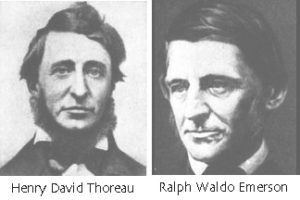Since my research in the field of AMERICAN LITERATURE focuses distinctly on writing from the AMERICAN TRANSCENDENTALISTS, the objects of study are condensed to writings created during a span of only a few years. While this may seem like a relatively small body of time and work, there are still immense literary annals devoted to writers from this period of time who dabbled with transcendental philosophies. Writers such as Margaret Fuller, Bronson Alcott, Louisa May Alcott, Theodore Parker, and even Nathaniel Hawthorne and Walt Whitman, all published works of transcendental literature; however, my explicit study focuses on RALPH WALDO EMERSON and HENRY DAVID THOREAU’S contributions. Historically, these two men produced the most essential works of transcendental literature, so their writings represent the most widely accepted objects of study in relation to American transcendental studies. Even more specifically, my study looks at Emerson and Thoreau’s political works, and many of these works can be found in the Transcendentalist Club’s distinct publication, THE DIAL, where the transcendentalists were able to “communicate and exert their influence” from 1840-1844 (Gould 1652).

When scholars analyze Emerson and Thoreau’s political essays and other literary contributions, there are myriad studies performed. Many scholars choose to analyze specific essays in order to identify contradictions, paradoxes, and incongruities among Emerson or Thoreau’s ideas. For example, Shawn St. Jean examined Thoreau’s “Resistance to Civil Government,” “Slavery in Massachusetts,” and the John Brown essays in order to deviate from normal perceptions and show that Thoreau actually shows consistency in his beliefs, even if those beliefs are altered by political and social upheavals (354). Meanwhile, although analyzing each writer’s potential inconsistencies is a common mode of study, there are plenty of other critics who analyze the writings of the time period in order to show how transcendental literature relates to other historic movements in the United States and the rest of the world. Myriad critics link America’s period of transcendentalism to the European Renaissance, England’s Restoration, America’s Southern Renaissance, or the Puritan influence, yet others see America’s renaissance as its own unique entity, one that is a revolt or completely groundbreaking in its approach. Nevertheless, after reviewing a majority of the objects of study, the more collective opinion is that the transcendentalist age was not a birth; instead, it was a renaissance that gathered inspiration from numerous previous ages while generating some of its own novel nuances (Fulton 407).
While some of these areas may be touched upon in my own research, my primary goal is to analyze Emerson and Thoreau’s works from a POSTCOLONIAL standpoint. While performing this research, looking at transcendental literature through a CULTURAL STUDIES lens is required. Since cultural/postcolonial studies are tied to the inception of the NEW CRITICISM in America, analyzing the transcendental works to identify how they fit into the New Criticism approach is necessary. Furthermore, in order to accomplish these tasks, the importance of the history of American literature studies also needs to be addressed to show how transcendental studies can help answer some of the major questions posed by scholars of both postcolonial and New Criticism studies. One of the major questions related to the New Criticism focuses on what works of literature were revived after WWI. As Gregory Paine notes, Emerson and Thoreau were two of the authors whose works rose in the “literary firmament” during the 1930s (631). This augmentation fits well with the New Criticism’s objectives to become a cultural and historical method where continuity could be charted in literary traditions in writings from the Puritans, Transcendentalists, and Romantics (Graff 217).
While this connection between the New Criticism, the Transcendentalists, and cultural studies may seem obvious, the inclusion of transcendental studies is often debated. Graff continues by noting that New Criticism’s emergence created a revival in unpopular writers like Melville and Thoreau, for the critics were attempting to scorn everything academic (213). The main hurdle here is that Emerson and Thoreau’s political works were often viewed by many scholars as primarily academic, and a major question as to transcendentalism’s place as a conservative or liberal movement must be posed. Obviously, most critics refer to the movement as liberal; however, certain elements of Emerson’s writings in particular display more conservative approaches that are unique but not radical. As Thomas P. Miller writes, “The New Criticism was instrumental in distancing literary studies from the more politically engaged schools of criticism that were popular in the Progressive era—those of “Leftists, or Proletarians…” (162). Miller’s statement muddies the water further, for it seems nearly impossible that the New Criticism can praise Thoreau while having contempt for academic and political literature.
The connections between the New Criticism and American transcendentalism are quite hazy, but most scholars find or consider major connections between transcendentalism and postcolonial studies. According to Kropf, “American literature, in contrast and uniquely among national literatures, defines itself according to geographical and political criteria” (21). This is precisely what transcendentalist writings do, and postcolonial studies remain part of this realm too. Perhaps Renu Juneja sums up postcolonial studies best when she says, “This is a literature that veritably forces on our consciousness, and at all various levels, the fact that ways of thinking are altered by this contact between two different cultures” (65). While this summation clearly articulates the value of postcolonial studies, it can simultaneously be used to define exactly what transcendental writers like Emerson and Thoreau endeavored to accomplish.
Works Cited
Fulton, Joe B. “Reason for Renaissance: The Rhetoric of Reformation and Rebirth in the Age of Transcendentalism.” The New England Quarterly 80.3 (2007): 383-407. JSTOR. Web. 21 October 2016.
Gould, Rebecca Kneale. “Transcendentalism.” Encyclopedia of Religion and Nature. ed. Bron Taylor. New York: Bloomsbury Academic Publishing, 2010, Print.
Graff, Gerald. “The Promise of American Literature Studies.” Professing Literature: An Institutional History. Chicago: University of Chicago Press, 1987, pp. 209-25. Print.
Juneja, Renu. “Pedagogy of Difference.” College Teaching 41.2 (1993): 64-70. EBSCOhost: Education Research Complete. Web. 18 October 2016.
Kropf, Carl R. “The Nationalistic Criticism of Early American Literature.” Early American Literature 18.1 (1983): 17-30. JSTOR. Web. 13 September 2016.
Miller, Thomas P. The Evolution of College English: Literacy Studies from the Puritans to the Postmoderns. Pittsburgh: University of Pittsburgh Press, 2011. Print.
Paine, Gregory. “Trends in American Literary Scholarship with Reviews of Some Recent Books.” Studies in Philology 29.4 (1932): 630-43. JSTOR. Web. 28 October 2016.
St. Jean, Shawn. “Thoreau’s Radical Consistency.” Massachusetts Review 39.3 (1998): 341-57. JSTOR. Web. 24 October 2016.
